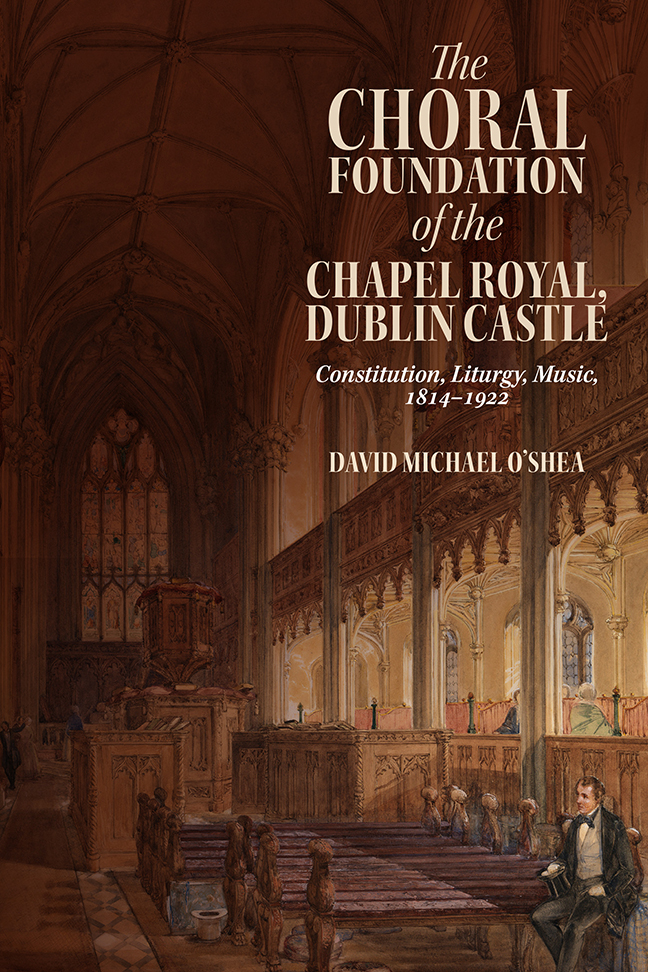Book contents
- Frontmatter
- Contents
- Illustrations
- Foreword
- Preface
- Acknowledgements
- A Note on Terminology
- Abbreviations
- Introduction
- 1 Precedents, Polity and Politics
- 2 Clergy
- 3 Churchmanship, Furnishings and Functions
- 4 The Musical Foundation
- 5 The Chapel Royal Music Collection
- 6 Singing the Liturgy
- 7 Organs
- 8 Boy Choristers
- 9 Gentleman Singers
- 10 Organists and Composers
- 11 The Chapel Royal's Legacy
- Conclusion
- Appendix A Lords Lieutenant, 1801–1922
- Appendix B Clergy of the Chapel Royal
- Appendix C Extant Chapel Royal Music Volumes (RCB MS 1113)
- Appendix D Boy Choristers of the Chapel Royal
- Appendix E Gentlemen Singers of the Chapel Royal
- Appendix F Organists of the Chapel Royal
- Appendix G Fragment of a Juvenile Chant by C. V. Stanford
- Bibliography
- Index
- Irish Musical Studies Previous volumes
- Frontmatter
- Contents
- Illustrations
- Foreword
- Preface
- Acknowledgements
- A Note on Terminology
- Abbreviations
- Introduction
- 1 Precedents, Polity and Politics
- 2 Clergy
- 3 Churchmanship, Furnishings and Functions
- 4 The Musical Foundation
- 5 The Chapel Royal Music Collection
- 6 Singing the Liturgy
- 7 Organs
- 8 Boy Choristers
- 9 Gentleman Singers
- 10 Organists and Composers
- 11 The Chapel Royal's Legacy
- Conclusion
- Appendix A Lords Lieutenant, 1801–1922
- Appendix B Clergy of the Chapel Royal
- Appendix C Extant Chapel Royal Music Volumes (RCB MS 1113)
- Appendix D Boy Choristers of the Chapel Royal
- Appendix E Gentlemen Singers of the Chapel Royal
- Appendix F Organists of the Chapel Royal
- Appendix G Fragment of a Juvenile Chant by C. V. Stanford
- Bibliography
- Index
- Irish Musical Studies Previous volumes
Summary
It is perhaps not generally understood that the services of the Chapel, held on Sunday mornings, which are of a high order of musical excel-lence, are open to the public.
This remark by Dean Mease, published shortly after his appointment as Dean in 1913, was not the first attempt made to draw the attention of the public to services at the Chapel Royal. Following the summer vacation in 1907, several notices appeared in the press announcing the recommencement of Sunday services and noting: ‘The chapel is open to the public for these services, which are fully choral.’ Such efforts to promote the Chapel would suggest that the staff believed the general public to be ignorant of (or perhaps apathetic to) the choral services there. This is no doubt one of the reasons that the choral foundation was so quickly forgotten after the Chapel's closure in December 1922.
The sudden disbandment of the Chapel Royal was part of the gradual winding-up of the Dublin Castle regime as the new independent Irish state was established, which began with the appointment of the Provisional Government and the symbolic handover of the Castle in January 1922. During the year that followed, the Castle government gradually transferred its functions to the new Provisional Government in preparation for the establishment of the Irish Free State. The viceregal household was gradually dissolved, and in August 1922 a civil servant described the Castle as ‘all but deserted […] the life has gone from it’. Nonetheless, services continued at the Chapel Royal, even after the Lord Lieutenancy was abolished with the inception of the Free State on 6th December 1922.
The determination of Hugh Jackson Lawlor and the staff of the Chapel's choral foundation to maintain services there even when the Chapel's constitutional raison d’être had ceased shows their determination to present the Chapel not merely as an appendage of the Lord Lieutenancy but as an independent institution worthy of preservation in the new constitutional order. This also shows how little the violence and division of the ongoing Irish Civil War seems to have touched the Chapel Royal. In contrast, the Irish government quite understandably did not consider the maintenance of the Chapel to be a priority, since civil war threatened the very survival of the new Free State. Thus, the Chapel quickly succumbed to political vicissitude, along with the rest of the institutions of the former viceregal establishment.
- Type
- Chapter
- Information
- The Choral Foundation of the Chapel Royal, Dublin CastleConstitution, Liturgy, Music, 1814-1922, pp. 230 - 234Publisher: Boydell & BrewerPrint publication year: 2023

